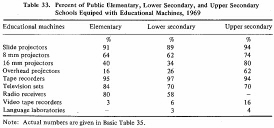| Home > Policy > White Paper, Notice, Announcement > White Paper > EDUCATIONAL STANDARDS IN JAPAN 1971 > CHAPTER |
||
In addition to pictures, models, slides, radios, and motion pictures, which have been traditionally used as instructional means, new kinds of educational machines have come to be employed in recent years. Such machines as television, tape recorders, and overhead projectors (OHP), which had not been used in classrooms until recently, are being introduced into daily educational activities. More recently, the direct or indirect utilization of computers for educational activities is being studied in many countries of the world. Among others, CAB (Computer Assisted Instruction) and CMI (Computer Managed Instruction) are being rigorously studied and developed. In July 1970, an International Seminar on the Uses of Computers in Education was held in Japan. In Japan, the use of computers together with response analysis apparatus is being studied, and it is expected to contribute considerably to the improvement of instruction. At present, approximately 140universities have computers. In a few elementary, lower secondary and upper secondary schools, computers are being used to experiment with individualized instruction or information management training.

Note: Actual numbers are given in Basic Table 35. Basic Table 35
The proportion of schools equipped with television sets, tape recorders, slide projectors, 8 rum projectors and other educational machines is very high.
In addition, such new devices as language laboratories, VTR, and response analysis apparatus have been introduced in recent years. Although the proportion of schools furnished with these machines is still low, the rate of increase is rapid. In the future when these machines have been furnished in most schools, effective usage of them will become an important problem.
The proportion of schools equipped with various kinds of educational machines is especially high in the U.S.A. For example, there is an average of one overhead projector per 101 public elementary and junior high school pupils. On the other hand, in Japan the figure is about one twentieth of this, i.e. one per 1,949 pupils. The number of pupils per 8 mm projector in the U.S.A. is 778 as against 1,132 in Japan. The number of pupils per slide projector is l07in the U.S.A. as against 231in Japan.
| Back to Top | MEXT HOME |